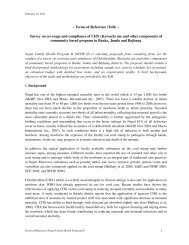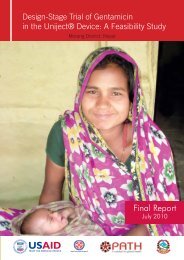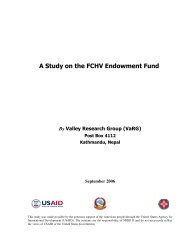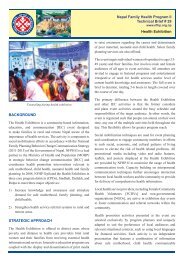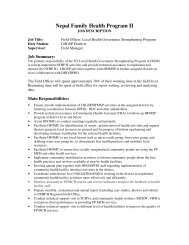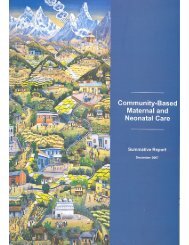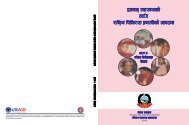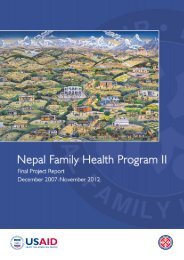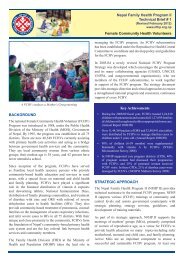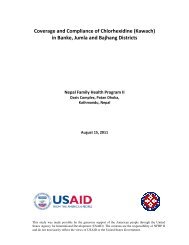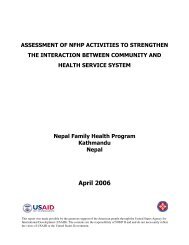Health Facility Management Strengthening Program - Nepal Family ...
Health Facility Management Strengthening Program - Nepal Family ...
Health Facility Management Strengthening Program - Nepal Family ...
You also want an ePaper? Increase the reach of your titles
YUMPU automatically turns print PDFs into web optimized ePapers that Google loves.
<strong>Nepal</strong> <strong>Family</strong> <strong>Health</strong> <strong>Program</strong> II<br />
Technical Brief # 17<br />
(Revised June 2012)<br />
www.nfhp.org.np<br />
<strong>Health</strong> <strong>Facility</strong> <strong>Management</strong> <strong>Strengthening</strong> <strong>Program</strong><br />
by HFOMCs on improving physical infrastructure and<br />
limited focus on quality issues; dalit and women members<br />
require more support than other HFOMC members.<br />
Participatory game for team building among members of the<br />
<strong>Health</strong> <strong>Facility</strong> Operation and <strong>Management</strong> Committee.<br />
BACKGROUND<br />
The vision of the Government of <strong>Nepal</strong> (GoN) for health<br />
and development focuses on self-reliance, community<br />
participation, and involvement of the private sector and<br />
non-governmental organizations (NGOs). In 1999, the<br />
government passed the Local Self-Governance Act, based<br />
on which the Ministry of <strong>Health</strong> and Population (MoHP)<br />
decided to decentralize health service management to local<br />
bodies. The intention of this initiative was to encourage<br />
local communities to take greater responsibility in managing<br />
local health facilities and health programs.<br />
The MoHP began the formal hand-over process of health<br />
facilities in 2002/2003. In 2003, the <strong>Nepal</strong> <strong>Family</strong> <strong>Health</strong><br />
<strong>Program</strong> (NFHP) helped the GON implement this initiative<br />
in NFHP’s 17 core program districts (CPDs). By 2006,<br />
this process was completed in 28 districts and involved<br />
1,433 HFs, with approximately half being supported by<br />
NFHP. Following this formal process, three-day capacity<br />
assessments and strengthening trainings were given by<br />
NFHP to 502 members of the new <strong>Health</strong> <strong>Facility</strong> Operation<br />
and <strong>Management</strong> Committees (HFOMCs).<br />
In 2006, NFHP assessed its input in this process, which<br />
revealed the following: mere hand-over of HFs to the<br />
communities did not meet program objectives; there was<br />
confusion about roles and responsibilities of different<br />
stakeholders; the hand-over of HFs should be thought of as a<br />
process not as a series of events; too much emphasis placed<br />
Based on these experiences, NFHP in close cooperation<br />
with the National <strong>Health</strong> Training Centre (NHTC) and<br />
other stakeholders engaged in capacity building of local<br />
health facilities developed a modified approach called<br />
Community and <strong>Health</strong> <strong>Facility</strong> as Partners (CHFP) which<br />
was implemented in 8 CPDs (Siraha, Sarlahi, Mahottari,<br />
Bara, Rautahat, Banke, Kailali and Bardia) covering 100<br />
village development committess (VDCs). After further<br />
refinement and modification of the CHFP approach, it was<br />
implemented by <strong>Nepal</strong> <strong>Family</strong> <strong>Health</strong> <strong>Program</strong> II in 4 CPDs<br />
(Banke, Kanchanpur, Surkhet and Dang) and covered 55<br />
VDCs.<br />
In 2009, NFHP II changed the name of the program to<br />
the <strong>Health</strong> <strong>Facility</strong> <strong>Management</strong> <strong>Strengthening</strong> <strong>Program</strong><br />
(HFMSP) to more accurately reflect program goals. After<br />
two years of HFMSP implementation in 55 VDCs and the<br />
favorable results collected through Technical Support Visits<br />
(TSVs), the approach was scaled up in 2010 in 557 VDCs<br />
of 9 additional districts (Rautahat, Sarlahi, Sindhuli, Rolpa,<br />
Pyuthan, Dailekh, Jumla, Kalikot and Salyan), covering a<br />
total of 612 HFs in 13 districts.<br />
STRATEGIC APPROACH<br />
NFHP II’s HFMSP approach seeks to improve the health<br />
of the community (with special focus on marginalized and<br />
underserved people) by empowering community members<br />
to manage their local HFs and other health programs. Key<br />
features of this approach include:<br />
<br />
<br />
<br />
Involving disadvantaged groups (e.g. dalits) in health<br />
facility management decision-making<br />
Delivering a complete package of interventions to<br />
develop knowledge and skills in managing health<br />
facilities, rather than one-time events like trainings<br />
Using simple, community friendly tools, guidelines,<br />
and training methods<br />
Focusing on building skills in organizational<br />
development, HF management, and health services<br />
provision using a phased-in model
Considering ways to scale-up from the very beginning<br />
of the program<br />
Involving and developing leadership skills of District<br />
Development Committees (DDCs)/District Public<br />
<strong>Health</strong> Offices (DPHOs) in order to institutionalize the<br />
HFMSP approach<br />
Sharing results and advocating for HFOMCs at the<br />
central level (i.e., among concerned ministries and<br />
external development partners)<br />
PROCESS<br />
The HFMSP approach involves a two year period of<br />
support (one year intensive implementation and one year<br />
limited technical support) including a three-day interaction<br />
session, periodic review meetings, regular follow-up, and<br />
promotional activities.<br />
Review Workshops<br />
Review workshops every 4-6 months help address<br />
gaps identified during TSVs. Focus is placed on further<br />
knowledge and skills enhancement in the areas of: resource<br />
mobilization; program monitoring and supervision; good<br />
governance; VDC health-need assessment and plan; and<br />
conducting visioning activities.<br />
Capacity of Dalit and Women HFOMC Members<br />
Though the current composition of the HFOMC is intended<br />
to be inclusive, dalit and women members have tended not<br />
to actively participate. Therefore, strengthening the capacity<br />
of dalit and women members is given a high priority through<br />
assessment and coaching.<br />
HFOMC members develop a social map to identify the dalits<br />
and poor in their community.<br />
Three-day Interaction Meeting with HFOMCs<br />
After initial self assessment of HFOMC capacity, a<br />
participatory, three-day training is conducted for HFOMC<br />
members to orient them on their roles/responsibilities,<br />
the importance of community representation and ways to<br />
improve social inclusiveness in access to and use of health<br />
services. Members develop skills to conduct effective<br />
meetings and prepare action plans to respond to gaps/issues<br />
identified by the committee.<br />
Technical Support Visits<br />
NFHP field officers, and D(P)HO staff conduct monthly<br />
TSVs to observe, coach, and facilitate HFOMC meetings.<br />
Information regarding gaps in knowledge and skills<br />
of HFOMC members is collected, action plans are<br />
implemented, and supportive supervision and follow-up is<br />
provided.<br />
Promotional Activities<br />
Promotional activities are carried out during the 1st year<br />
of intensive implementation, to create awareness among<br />
people about HFs, HF services and HFOMCs, and to build<br />
trust between the community and HFs.<br />
Advocacy Meeting at District Level<br />
Advocacy programs with DDC and VDC secretaries are<br />
organized periodically to update them on HFMSP progress,<br />
as well as to advocate for: resource mobilization; increased<br />
supervision, monitoring, and support to HFOMCs; and<br />
increased linkages between the VDC, DDC, D(P)HO, and<br />
HFOMC.<br />
Progress monitoring<br />
At the end of one-year intensive HFMSP implementation,<br />
self-assessment of HFOMC is undertaken again to assess<br />
the status of HFMSP-supported HFOMCs and to facilitate<br />
development of strategies for future technical support (but<br />
more limited).
RESULTS<br />
Community participation through active engagement of<br />
HFOMCs in the management of HFs is one of the key<br />
successes under HFMSP. Data shows increases in regular<br />
and effective 1 HFOMC meetings (Figure 1), gathering<br />
of issues from the community, prioritization of issues,<br />
development of action plans based on local health needs,<br />
and sharing of decisions with the community.<br />
Figure 1: Community participation-HFOMC meeting<br />
Participation in HFMOC meetings by at least one dalit<br />
member increased significantly from 30% in 2008 to 61%<br />
in 2011. Dalit proportion among all HF clients versus dalit<br />
proportion among catchment population has also increased<br />
over the monitoring period from 1.41 to 1.47.<br />
LESSONS LEARNED<br />
Capacity building<br />
Capacity building is a continuous process. It requires<br />
continuous engagement, and training needs to be backed<br />
by periodic follow-up, coaching and refreshers.<br />
Targeted support for marginalized populations is key.<br />
Regular coaching for dalits and female members on<br />
their roles and responsibilities has been very productive.<br />
Parallel interventions on livelihood and educational<br />
empowerment of the marginalized also need to be<br />
undertaken to ensure their meaningful and sustainable<br />
participation during meetings.<br />
The HFMSP was quite successful at mobilizing local<br />
resources for health through HFOMCs, from VDCs and<br />
local organizations (Table 1). The resources were used<br />
to hire local staff, infrastructure, conducting awareness<br />
activities, and staff motivation.<br />
Table 1: Mobilization of local resources*<br />
HFOMC<br />
mobilized<br />
resources<br />
Baseline<br />
2008<br />
Nov<br />
2010-March<br />
2011<br />
April-<br />
Sept<br />
2011<br />
Oct<br />
2011-March<br />
2012<br />
From VDC 57% 86% 88% 86%<br />
From other<br />
organizations<br />
20% 50% 58% 59%<br />
* Among percentage of sampled HFOMCs<br />
HFOMC priorities have shifted from addressing basic<br />
infrastructure/commodity issues to more sophisticated<br />
service and program-related ones, including good<br />
governance. HFOMCs are increasingly involved in regular<br />
supervision and monitoring of HF; conducting social audits;<br />
and displaying citizen charter in HFs. As a result, the number<br />
of HFs running as per schedule and staff availability in HF<br />
has increased over the project period.<br />
1<br />
Effective meetings is defi ned as the % HFOMCs that: held a meeting in the last month<br />
with participation of 51% HFOMC members with at least a dalit and women member;<br />
prepared action plans; and shared responsibilities among HFOMC members.<br />
The HFMSP is only a part of overall HFOMC capacity<br />
building. Other means of capacity building like policy<br />
and fund support are also necessary.<br />
Moving from comparatively simple activities to more<br />
complex ones is an effective approach to slowly build<br />
HFOMC capacity over time.<br />
HFOMC involvement in all aspects of HF management,<br />
programs and activities is necessary to develop their<br />
capacity. HFOMC members need continual exposure to<br />
health-related issues to empower them.<br />
Representation<br />
The selection process for committee members should be<br />
done through the public gathering process to increase<br />
community accountability. The structure should be<br />
inclusive in nature and should ensure that the chosen<br />
individuals are motivated and competent (or have the<br />
potential to be competent), in order to maintain a spirit<br />
of active voluntarism and group empowerment. In many<br />
cases, locally nominated chairpersons have performed<br />
better than VDC secretaries.<br />
Relationship of HFOMC with HF staff and wider<br />
community<br />
How effectively committees function is largely<br />
determined by the relationship between HF staff and<br />
HFOMC members; the relationship among HFOMC<br />
members from different political background; and<br />
between HFOMCs and the wider community.
REFERENCES:<br />
1. National <strong>Health</strong> Training Center. Directives of <strong>Health</strong><br />
<strong>Facility</strong> Handover and Operation, 2060.<br />
2. Department of <strong>Health</strong> Services. Annual Report,<br />
2005/06.<br />
3. <strong>Nepal</strong> <strong>Family</strong> <strong>Health</strong> <strong>Program</strong>. Assessment of NFHP<br />
activities to strengthen the interaction between<br />
community and health service system, 2006.<br />
4. <strong>Nepal</strong> <strong>Family</strong> <strong>Health</strong> <strong>Program</strong>. Review of activities<br />
undertaken by NFHP and its partners to strengthen the<br />
partnership between Community and <strong>Health</strong> Facilities,<br />
2007.<br />
5. <strong>Nepal</strong> <strong>Family</strong> <strong>Health</strong> <strong>Program</strong> II. <strong>Health</strong> <strong>Facility</strong><br />
Assessment 2012.<br />
6. HFMSP program monitoring data.<br />
7. Gurung G. Capacity building is not an event but<br />
process: Lesson from health sector decentralization of<br />
<strong>Nepal</strong>. <strong>Nepal</strong> Med Coll J 2009; 11(3): 205-206.<br />
8. Gurung G. <strong>Nepal</strong> health sector decentralization in<br />
Limbo: What are the bottlenecks? <strong>Nepal</strong> Med Coll J<br />
2011; 13(2): 137-139.<br />
The program/research described in this article was supported under the <strong>Nepal</strong> <strong>Family</strong> <strong>Health</strong> <strong>Program</strong> II which is made possible by the generous<br />
support of the American people through the United States Agency for International Development (USAID). The contents are the responsibility of<br />
NFHP II and do not necessarily reflect those of USAID or The United States Government.<br />
NFHP II is implemented by JSI Research and Training Institute, Inc., in partnership with Engender <strong>Health</strong>, Jhpiego, Save the Children,<br />
World Education, Inc., <strong>Nepal</strong> Technical Assistance Group, <strong>Nepal</strong> Fertility Care Center, <strong>Management</strong> Support Services Private Ltd.,<br />
<strong>Nepal</strong> Red Cross Society, United Mission to <strong>Nepal</strong>, BBC Media Action, Digital Broadcast Initiative Equal Access <strong>Nepal</strong>, <strong>Family</strong> Planning<br />
Association of <strong>Nepal</strong> and Center for Development and Population Activities.



